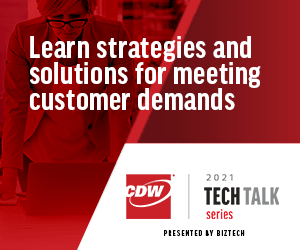Investing in AI Is ‘Mission Critical’
Paikeday began by saying, “I think those who don't use or see AI as mission-critical are probably still looking at it as a science project or something reserved for hyperscalers or academia. But the reality is that manufacturers are using AI to increase the uptime of valuable equipment and assets with predictive maintenance. Retailers are using it to deliver enhanced customer experiences with natural language understanding and recommender systems. Healthcare providers are using it to improve clinical outcomes with AI-guided radiology.”
Paikeday said that well-managed organizations use periods of turbulence, like the pandemic, “to strengthen customer relationships, reduce costs and increase agility, something that AI is incredibly good at.”
He cited statistics to support his point about the pandemic. “Over the past 12 months, the average enterprise spent about $1.5 million on AI infrastructure. Sixty-four percent have increased their spend due to COVID-19, and 82 percent are going to increase that spend over the next 12 months. So, that tells me that now more than ever is the right time to double down on AI.”
AI Projects Can Be Challenging to Operationalize
Paikeday said that while many organizations see the need for AI, they frequently don’t know how to take it from a proof of concept to an operationalized state because it isn’t like conventional software. “Gartner will tell you that AI projects take on average 8.6 months to deploy, which I think is especially the case when done in the absence of an IT platform purpose-built for AI development and deployment. And almost 50 percent of AI projects never get that far and are abandoned or even stall out.”
Paikeday offered his theory on why AI models can take so long to operationalize. “It's resource-intensive work done by what I call data science artisans, people who are hard to find, expensive to hire, difficult to retain, and whose output is largely opaque to anyone who wants to understand how these models work. These folks love to experiment, they work with algorithms, but they're not software engineers. Most are disconnected from IT and often operate outside of good IT DevOps practices. So while they'll help you create a great AI model, they're not going to be able to see it into production.
“And once the model is deployed, the work isn't over, model retraining on a regular basis is required since they tend to drift, they tend to lose accuracy over time while processing live production data. So it's an ongoing, iterative, continuously evolving workflow that's in desperate need of a robust platform that can streamline the process from concept to production application.”
AI Development Consumes Resources Differently
Paikeday pointed out the differences in the way AI consumes resources compared with more typical enterprise workloads. “Model training requires having enough computational power in combination with ultrahigh-performance storage to feed data sets into the training process, with everything connected over a very-high-speed, low-latency network. These resources need to be designed in an optimal balance that ensures linearly predictable performance at scale. Without such a design approach, you could be throwing more and more capital at infrastructure but not getting the return you need.”
Paikeday also highlighted the need to involve various skill sets and multiple stakeholders to bolster a project’s chances for success. “If you're thinking about this from a project perspective or just getting your project off the ground, I'd say, first of all, you need to understand this is a team sport,” he said. “You do need to employ a multidisciplinary team that includes a data engineer, business analysts and data scientists. DevOps should be involved, probably an application developer who can help wrap your application, your AI model in code. You should be working very closely with a business analyst or the business unit that understands the use case relative to the problem that’s being solved, that hopefully has revenue or revenue impact associated with it.”













